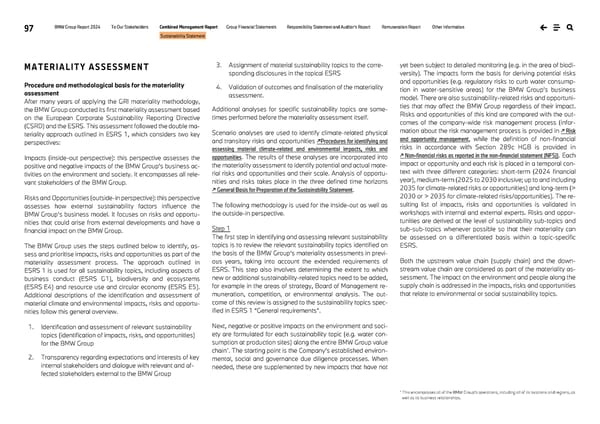97 BMW Group Report 2024 To Our Stakeholders Combined Management Report Group Financial Statements Responsibility Statement and Auditor’s Report Remuneration Report Other Information Sustainability Statement MATERIALITY ASSESSMENT Procedure and methodological basis for the materiality assessment After many years of applying the GRI materiality methodology, the BMW Group conducted its first materiality assessment based on the European Corporate Sustainability Reporting Directive (CSRD) and the ESRS. This assessment followed the double ma- teriality approach outlined in ESRS 1, which considers two key perspectives: Impacts (inside-out perspective): this perspective assesses the positive and negative impacts of the BMW Group’s business ac- tivities on the environment and society. It encompasses all rele- vant stakeholders of the BMW Group. Risks and Opportunities (outside-in perspective): this perspective assesses how external sustainability factors influence the BMW Group’s business model. It focuses on risks and opportu- nities that could arise from external developments and have a financial impact on the BMW Group. The BMW Group uses the steps outlined below to identify, as- sess and prioritise impacts, risks and opportunities as part of the materiality assessment process. The approach outlined in ESRS 1 is used for all sustainability topics, including aspects of business conduct (ESRS G1), biodiversity and ecosystems (ESRS E4) and resource use and circular economy (ESRS E5). Additional descriptions of the identification and assessment of material climate and environmental impacts, risks and opportu- nities follow this general overview. 1. Identification and assessment of relevant sustainability topics (identification of impacts, risks, and opportunities) for the BMW Group 2. Transparency regarding expectations and interests of key internal stakeholders and dialogue with relevant and af- fected stakeholders external to the BMW Group 3. Assignment of material sustainability topics to the corre- sponding disclosures in the topical ESRS 4. Validation of outcomes and finalisation of the materiality assessment. Additional analyses for specific sustainability topics are some- times performed before the materiality assessment itself. Scenario analyses are used to identify climate-related physical and transitory risks and opportunities ↗Procedures for identifying and assessing material climate-related and environmental impacts, risks and opportunities. The results of these analyses are incorporated into the materiality assessment to identify potential and actual mate- rial risks and opportunities and their scale. Analysis of opportu- nities and risks takes place in the three defined time horizons ↗ General Basis for Preparation of the Sustainability Statement. The following methodology is used for the inside-out as well as the outside-in perspective. Step 1 The first step in identifying and assessing relevant sustainability topics is to review the relevant sustainability topics identified on the basis of the BMW Group’s materiality assessments in previ- ous years, taking into account the extended requirements of ESRS. This step also involves determining the extent to which new or additional sustainability-related topics need to be added, for example in the areas of strategy, Board of Management re- muneration, competition, or environmental analysis. The out- come of this review is assigned to the sustainability topics spec- ified in ESRS 1 “General requirements”. Next, negative or positive impacts on the environment and soci- ety are formulated for each sustainability topic (e.g. water con- sumption at production sites) along the entire BMW Group value chain*. The starting point is the Company’s established environ- mental, social and governance due diligence processes. When needed, these are supplemented by new impacts that have not yet been subject to detailed monitoring (e.g. in the area of biodi- versity). The impacts form the basis for deriving potential risks and opportunities (e.g. regulatory risks to curb water consump- tion in water-sensitive areas) for the BMW Group’s business model. There are also sustainability-related risks and opportuni- ties that may affect the BMW Group regardless of their impact. Risks and opportunities of this kind are compared with the out- comes of the company-wide risk management process (infor- mation about the risk management process is provided in ↗ Risk and opportunity management, while the definition of non-financial risks in accordance with Section 289c HGB is provided in ↗ Non-financial risks as reported in the non-financial statement (NFS)). Each impact or opportunity and each risk is placed in a temporal con- text with three different categories: short-term (2024 financial year), medium-term (2025 to 2030 inclusive; up to and including 2035 for climate-related risks or opportunities) and long-term (> 2030 or > 2035 for climate-related risks/opportunities). The re- sulting list of impacts, risks and opportunities is validated in workshops with internal and external experts. Risks and oppor- tunities are derived at the level of sustainability sub-topics and sub-sub-topics whenever possible so that their materiality can be assessed on a differentiated basis within a topic-specific ESRS. Both the upstream value chain (supply chain) and the down- stream value chain are considered as part of the materiality as- sessment. The impact on the environment and people along the supply chain is addressed in the impacts, risks and opportunities that relate to environmental or social sustainability topics. * This encompasses all of the BMW Group’s operations, including all of its locations and regions, as well as its business relationships.
 BMW Group Report 2024 Page 96 Page 98
BMW Group Report 2024 Page 96 Page 98